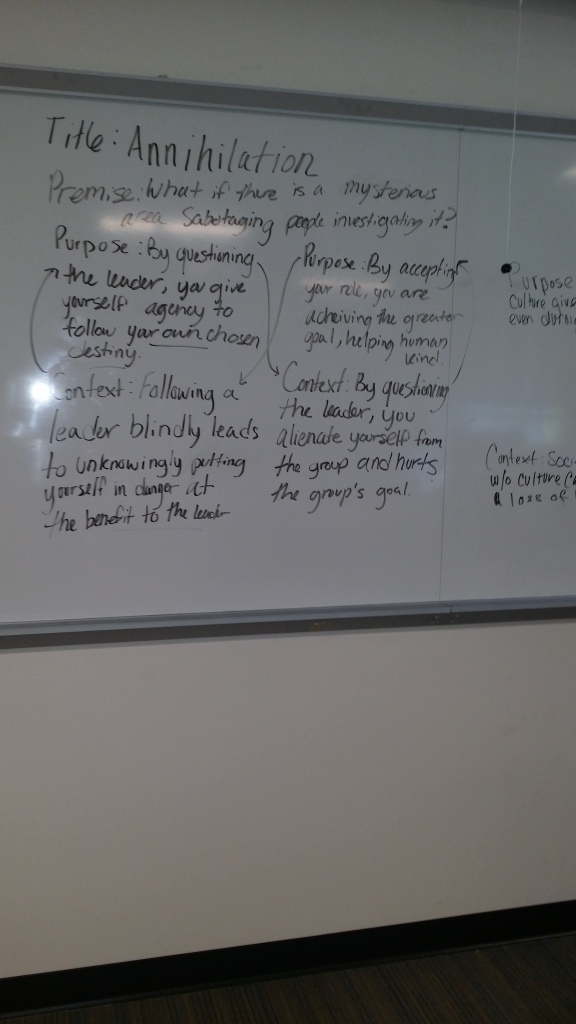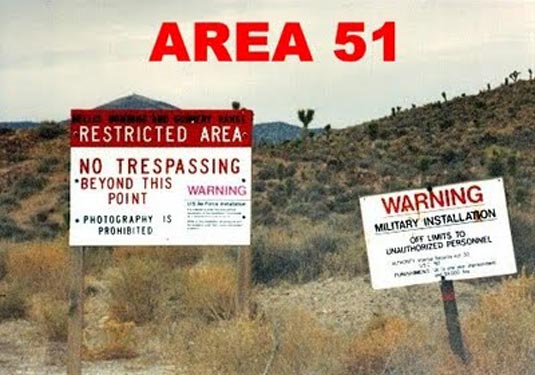My group members and I are about ¾ of our way through the crazy adventure of Annihilation. For those of you just joining our conversation on the book, Annihilation by Jeff Vandermeer is a part science fiction part thriller novel that follows four members who are researching this mysterious area referred to as Area X. This location has been cut off from the rest of the world by a border for reasons that are unknown to the public. Throughout the reading, I have noticed that many of Barthe’s intertextual codes are evident in the text, but the one that stuck out the most to me was the Semic code. Barthe Describes the semic code as a technique used to define a character, object or place.
“The semic code defines characters, objects, and places through repetitively grouping a number of signifiers (“semes”: words and phrases) around a proper name. Because this code defines characters, objects. and places, the semic code sets up relationships of power that often reinforce cultural codes. (Barthe)”
In other words, the Semic code is responsible for creating connotated meaning that delves deeper than the denotative meaning. I believe that a perfect example of this is Area X itself.
In the text, we follow four scientists who are recording and mapping observations of a location referred to as Area X. I could not help but recognize the references, or similarities, to Area 51. In fact the only major differences between the two locations is that one is located in a desert (Area 51) and the other is in a location that is overpopulated with lichen and other plants (Area X). Both places, however, are characterized by being a Government contained area that host mysterious and secretive activities. We see here that on page 94, Area X is described as a result of military research.
“The government’s version of events emphasized a localized environmental catastrophe stemming from experimental military research.” (P.94)
This is interesting considering that Area 51 is also an area characterized by government military research. I believe that Area 51 is included in the text to be used as a metaphor, a semic code implemented to define Area X to the readers, so that they can better relate to the text.
For those of you who are unfamiliar with Area 51, it is an off limits military air force base located in a remote desert area in Nevada. The area is surrounded by a border that is guarded by cameras, a drop gate, and men with guns. Many claim to have seen unidentifiable flying objects (UFOs) and alien life forms wandering around. The government claims to use the base as an area to test air crafts. However, because of its mysterious nature, It has long been an inspiration for many other books, movies, and tv shows.
(Area 51 video)
Often times throughout the text, Area X is described as a mysterious, eerie, and oddly beautiful location that is surrounded by a border and full of life forms, some alien or unknown, that have adapted. This border is continually expanding and the government sent the group in to attempt to figure out why. Past expeditions have ended in death and the members of the twelve expedition must avoid becoming contaminated.

So why would Jeff Vandermeer decide to reference this in the text? I think this intertextual play reinforces the network of controlling values that my group identified in blog 1.

By comparing Area X to Area 51, the reader begins to understand how mysterious and unknown this location is. You begin to realize how the members of the group could blindly be lead into danger. For example, our narrator, the biologist, is faced with the choice of either following the leader blindly, knowing that the leader may know something that she does not, or questioning what she is told. We see this is evident on pages 38-39 when the biologist realizes that the psychologist maybe withholding information from the group.
“We had a choice now. We could accept the psychologist’s explanation for the anthropologist’s disappearance or reject it. If we rejected it, then we were saying the psychologist had lied to us, and therefore also rejecting her authority at a critical time”. (P.39)
It is at this moment in the text that the weight of how serious and dangerous this situation could be hits the biologist. We get a sense that the government may be lying to our characters and leading them unwillingly into danger. It is almost as if the members of this expedition are lab rats or guinea pigs, sent in to see what is going on in this area to the benefit of the government. To prove how indispensable the members are they are not referred to as their real names but their job titles. Again the semic code is evident in this piece of text. “There were four of us: a biologist, an anthropologist, a surveyor, and a psychologist.” (P.3) This demonstrates how they were treated as test dummies rather than living breathing humans with families and outside lives. This reinforces the cultural code of it is a “dog eat dog world.” We hear the statement all the time but what does it mean? According to the Cambridge English dictionary, the phrase “dog eat dog” is used to “describe a situation in which people will do anything to be successful, even if what they do harms others.” Kind of like, how these government officials are inviting these members in knowing they most likely will not survive.
As my group members and I finish up this book, I am curious to see if the cultural and semic codes that I have identified still ring true. Also note, that this is an example of only one way to look at the text. There are many other possibilities of values and controlling ideas that are evident in the text.
GIFs from Giphy

Brittany great blog! To add to it I thought I take a gander at the Hermeneutic code in relation to monster/creature in reeds. The team had been hearing the strange moaning since their arrival in Area X, building a curious thought about what the sound could belong to. As the reader we experience this with the biologist, we wonder but forget it when the sound isn’t present. But then, as the Biologist is returning from her trip to the lighthouse we hear the sound again, and we are in the reeds where it lives. We still do not see the creature but we creep along with the Biologist and hope it doesn’t spot us, but we are ever curiouser because it is so close. I want to know what the creature is, as does the Biologist. This whole ordeal moves through all of the steps of the code, and when the Biologist is almost got by the thing it loses most of its significance, yet like all the creatures in Area X we still wonder. What was it really? Is it somehow human, under all the monstrosity of it, under the guttural moan?
LikeLike
Thanks for another great blog, Brittany!
I wanted to look at a possible Symbolic code which “Generates unresolvable oppositions (what are called “antitheses”) that structure a given conflict”
I want to quickly focus on the Biologist versus the Surveyor.
The Biologist is independent and likes to make her own choices. The Surveyor, who has a militaristic background, prefers to “stay in line” and follow orders.
The Biologist is mostly calm and thinks things through, while the Surveyor is hot-tempered and will attack will little thought.
The Biologist takes great interest in the biology of Area X, while the Surveyor is more interested in following her orders and surveying the land.
They are opposite sides of a coin, and that conflict doesn’t resolve, leading to a deadly exchange where the Surveyor dies.
-Alex
LikeLike
First off, I love the parallels that you drew between Area 51 and Area X, as they are basically equivalent in their mysterious elements, and the nature represented by them. Area 51 is commonly described as a place where the government experiments with new weaponized technology, and as we learn early on in the book, Area X was allegedly the creation of military research gone wrong.
However, I feel that you spend perhaps a little too much time on this comparison in spite of the Semitic Code, the code most prevalent from the very beginning in Annihilation, seeing as the characters are never once referred to by their specific names. Rather, they are referred to by their roles, almost like machines with designated purposes, which hints towards what kind of world that they came from, and possibly, the intentions behind the mission itself. Much of the book’s focus is put on the Psychologist, a term in real life that we would typically associate with those who are there to overcome difficult times in our lives, but the author cleverly uses this against the reader, showing that the Psychologist’s true role in the mission may indeed be something much more sinister when she eventually gives the failed command for the Biologist to commit suicide through hypnosis.
LikeLike